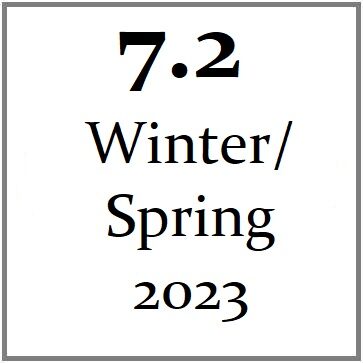He Looks Like Me in the Future!: Using Afrofuturism as a Teaching Tool in the Elementary Classroom
Tiara Brown, PhD, James Madison University
Throughout my 15-plus years as an educator, and current professor of education, I have seen many challenges in elementary settings. Teachers face constant pressure to teach the subject matter, but they are also responsible for the emotional well-being of their students. As a former teacher, I was constantly bogged down by academic content and felt it was difficult to teach the necessary abilities of resiliency, inclusivity, and acceptance. Public schools are changing, and the current premise is to educate the whole child. According to Darling-Hammond and Cook Harvey in Educating the Whole Child: Improving School Climate to Support Student Success. "A whole child approach to education is one that recognizes the interrelationships among all areas of development and designs school policies and practices to support them." This means that academics are not the only focus. I have also seen children I taught, and my own children, struggle with their emotions and learning to accept others in the classroom. With this in mind, I believe the three main challenges in United States public education are the following:
- the ability to teach factual content that is engaging,
- the importance of instilling resilience and supporting social-emotional skills, and
- the aptitude of teachers to foster a community of inclusivity and acceptance.
Afrofuturism as a Teaching Tool to Address Challenges
Considering these challenges, I am continuously looking for creative solutions. Recently, I watched the film Black is King directed, written, and produced by American singer Beyoncé, and something clicked. A synopsis of the film, on Disney+, describes the cinema as a "tale about a young king’s transcendent journey through betrayal, love and self-identity" where "his ancestors help guide him toward his destiny." Beyoncé had a vision to use science-fiction, through a diverse cast, to "showcase the beauty and richness of the cultures in the African continent and diaspora." This concept is recognized as Afrofuturism.
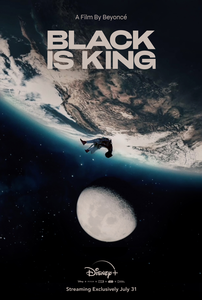
Black Is King promotional poster, 2020. Public domain, via Wikipedia Commons.
Mark Dery invented the term Afrofuturism in his 1994 essay "Black to the Future: Interviews with Samuel R. Delany, Greg Tate, and Tricia Rose" as a form of “speculative fiction that treats African American themes and addresses African American concerns in the context of the twentieth century technoculture.” Recent scholars in Afrofuturism have modernized the definition with a changing society. Ytasha Womack via Pratt Institute Libraries defines Afrofuturism as “A way of looking at the future and alternate realities through a Black cultural lens.” In the publisher’s summary of Afrofuturism: The World of Black Sci-Fi and Fantasy Culture, Womack further defines the concept as an “aim to both entertain and enlighten” where “Afrofuturists strive to break down racial, ethnic, and social limitations to empower and free individuals to be themselves”. This cultural movement uses a frame of science fiction and fantasy to address these social aspects through art, movies, music, clothing, technology, and many other platforms. Scholars, artists, and activists like John Jennings, Reynaldo Anderson, Julian Chambliss, and many others pave the way for self-expression through these platforms. A quick glance into their creative works opens a wide door for teachers to use Afrofuturism concepts in their classrooms. Through lessons and activities, elementary educators can use Afrofuturism as a means for expression and engagement with the aforementioned platforms.
After much thought and research, I realized multiple goals could be accomplished by using an Afrofuturistic lens in an elementary setting. For teachers, this allows for lessons to explore the past and present conditions of African peoples through multi-genre platforms including science fiction, technoculture, play, and the arts. It is my assertion that Afrofuturism can be used as a teaching tool to achieve three desired outcomes challenging schools:
- impart academic content that is factual but engaging,
- promote resilience and social-emotional skills, and
- encourage an inclusive and accepting learning environment in the classroom.
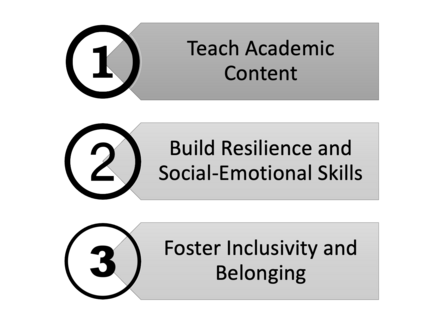
Three outcomes of using Afrofuturism as a teaching tool.
Impart Academic Content That is Factual but Engaging
Michael Unger in "Why Kids Like to Go To School, and Why They Don't" explains, "Research shows that our children, no matter what their age, ethnic background, or where they live, want to feel engaged at school. They want to feel like they belong and that what they do at school matters." This is often difficult to do with the pressures of standardized testing across the core subjects of mathematics, literacy, social studies, and science. The beauty, however, is despite these pressures, teachers do have some sovereignty over instructional content. So, how can Afrofuturism serve as a tool for engagement for core and factual academic subjects? This will be explored in the following section.
Sydney Scott, in "A Beginner's Guide To Afrofuturism: 7 Titles To Watch And Read," created a list of seven movies and books that are respectable representations of Afrofuturism. Although many books, movies, and music focus on an older audience, teachers of young children have a plethora of additional options. Let’s say an elementary teacher is conducting a lesson on space exploration. Rather than a typical social studies discussion of the Caucasian men and Apollo 11, he or she could show the short film Afronauts which uses Afrofuturism to portray an alternate reality in 1960s Zambia. This film emphasizes the struggles of African peoples, during this time, but then empowers them through a future of sophisticated sci-fi technology.
In addition to the Apollo 11 example as an example of a history lesson, literacy instruction can be a powerful tool to utilize concepts of Afrofuturism. For example, teachers can create a multitude of writing prompts, combining subject areas, for young children that focus on components of Afrofuturism including:
Science prompt: "Thinking about our discussion of evolution, how do you see the world in 100 years for yourself and for those of another race?"
Social Studies prompt: "Using our discussion of Martin Luther King, Jr.’s 'I Have a Dream' speech, how do you think this speech would change for his audience in the year 3021?"
Some of this work has already been done. A school even incorporated Afrofuturism into Science, Technology, Engineering, and Mathematics (STEM) education. A complete lesson by Angela McByrd, entitled "Afrofuturism in Black Panther: STEM Focused," was used to define the concept and discuss science and mathematical concepts through the use of holograms in the movie Black Panther. The results of the lesson were encouraging for content knowledge and engagement. Activities and lessons like these use Afrofuturism to engage students but also teach critical academic components that are required by the public education system.
Promote Resilience and Social-Emotional Skills
In addition to academic content, teachers can capitalize on this chance to teach resiliency through Social Emotional Learning (SEL) by presenting challenges African American’s face through the use of Afrofuturistic content. Promoting SEL and resilience is critical to the long-term success of students. Aperture Education defines SEL as "the process through which children and adults acquire and effectively apply the knowledge, attitudes, and skills necessary to understand and manage emotions” and “feel and show empathy for others." They also define resilience as “the ability to succeed in school despite adverse conditions such as poverty, family background, or abuse.” According to Kathy Perez in "Fostering Resilience Through Social-Emotional Learning," one of the ways teachers can combine these skills is to "[c]reate a culture of compassion that embraces marginalized students." This is where Afrofuturism can come into play.
I was recently introduced to a real-life example of SEL through Afrofuturism myself. As an education professor, I am often in elementary classrooms to supervise my pre-service teachers or provide assistance when needed. Several months ago, an African American student asked the teacher if his grandparents “used to be slaves.” The teacher shied away from the concept and quickly diverted the topic, but could she have done something differently? Using the concepts of Afrofuturism, this teacher could have created an assignment or discussion to allow the child to explore this question. When I asked a colleague in African American and Diaspora Studies about this particular incident, she stated, “Has the child seen the movie Black Panther?” I had not thought about this as a connection, but this movie was extremely popular among young African American children at this time. The film centered on Afrofuturism, and the main character overcame fears to become protector of an imaginary nation. My colleague’s suggestion was to encourage this dialogue between teacher and student and use this movie as an example of the promise of Black greatness despite generational trauma. When I then asked about the rest of the class, she immediately hit on the second resilience strategy of self-compassion. Afrofuturistic content in the classroom does not only have to be for the Black children. According to Chanel Miller, in "The Importance of Promoting Diversity in Early Childhood Programs," students from all backgrounds can practice self-compassion by incorporating experiences in school that “point out differences and similarities of children within the class, showing that you are all one community but have things about you that make you unique.” That is, enjoyable activities with meaningful content about African history exposes an entire classroom to truths, resilience, and achievement for an abler future…if done correctly.
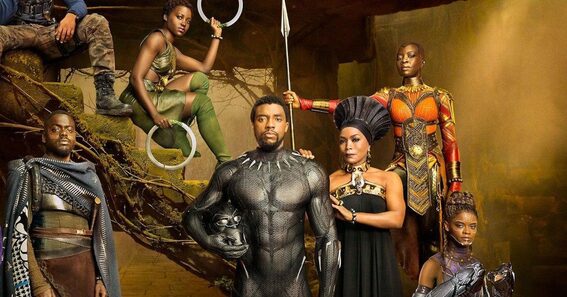
Depiction of characters from the first Black Panther film. Photo by Marvel Studios.
Encourage an Inclusive and Accepting Learning Environment in the Classroom
Finally, in addition to academic engagement, SEL, and resilience, I deem Afrofuturism can bring a classroom community together. An article from American University entitled "The Benefits of Inclusion and Diversity" in the classroom states, "An in-depth research review of dozens of other studies on diversity" concluded that "having different and divergent perspectives can create positive learning outcomes." With the changing demographics of the United States education system, teachers will be continuously challenged to encourage acceptance and inclusivity.
According to a blog from Dropbox, entitled "Why Are Children So Creative? The Link Between Childhood and Creativity," children are creative and imaginative. More specifically, "Children are divergent thinkers, capable of producing a range of ideas — freely, generously, and without an inner critic taking notes." In my experience, this divergent thinking allows children to imagine ideas without bias. While imagination is one of the core characteristics of Afrofuturism, teachers can capitalize on these strengths of children in a variety of ways.
Recently, a pre-school in Washington, D.C. aimed for inclusivity by using inspiration from Afrofuturist artist, Cyrus Kabiru, The goal was to create eye-glass art projects using trash products to depict trash as receiving a second chance. This symbolized a futuristic aspect, similar to the notion of learning about the African diaspora and overcoming obstacles. The teacher noted she could see "where children were dancing or experimenting, constructing and creating, all while centering the Afrofuturist ideals of Cyrus Kabiru." She also stated, "Like Cyrus, I will ask them to imagine a new and better future and tell a bit of their story." This project is a prime example of the possibility to incorporate key components of Afrofuturism even for the youngest of learners while creating an inclusive environment accepting of everyone in the classroom.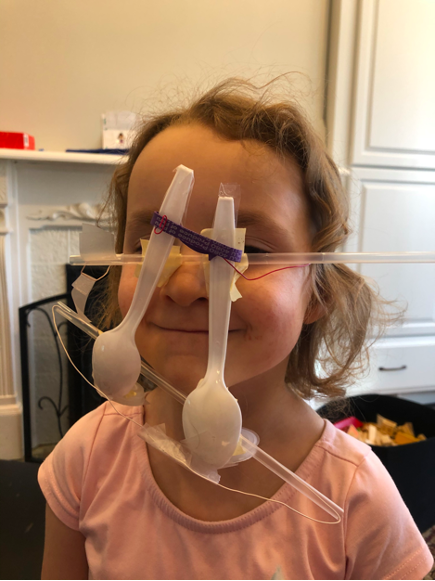
Image of Afrofuturistic art inspired by Cyrus Kabiru. Image from Marla McLean's description of the assignment.
Several additional classroom community-building experiences can be utilized. First, students can work on an art project that depicts a futuristic costume. Students can then explain where they are in the future and what the costume means to them. Another idea would be a play-based science area with items that represent African traditions and futuristic objects for dramatic play. Additionally, technology can serve for students to research aspects of Afrofuturism and allow the next generation of African Americans to explore past histories to create their own freer future. Each of these activities allows young children, whose minds are less corrupt from societal pressures, to engage in an accepting learning environment.
In conclusion, teaching is a difficult profession even without the pressures of inequality, inclusion, and standardized tests. It is my assertion that by integrating viewpoints of Afrofuturism into the classroom, children can prosper. Evidence suggests students can build social-emotional skills and resilience while also understanding and dissecting essential academic content. We know teachers cannot save the world, but by being creative and engaging with Afrofuturistic ideals, THEY can help cultivate a sense of belonging and hope for a freer future. According to Taylor Crumpton in the article "Afrofuturism Has Always Looked Forward," “Believe Black protesters when they chant, 'I’ve been to the future. We won.'" So, what if we invigorated students to use their imaginations as encouragement for future transformation in the world? I challenge all elementary teachers to think about this, examine the concept, and get started themselves.
References
American University. (2019, July 24). The benefits of inclusion and diversity in the classroom. Retrieved from https://soeonline.american.edu/blog/benefits-of-inclusion-and-diversity-in-the-classroom/
Aperture Education.(2022). What is social-emotional learning? Retrieved from https://apertureed.com/what-is-social-emotional-learning/
Bodomo, N. (2019). Afronauts. [Short film]. Sundance Institute, Tribeca Film Institute, and Cinereach.
Anderson, R. (n.d.) Reynaldo anderson. Retrieved from https://liberalarts.temple.edu/about/faculty-staff/reynaldo-anderson
Black is king. (2022, December 7). Retrieved from https://en.wikipedia.org/wiki/Black_Is_King
Chambliss, J. (2022, August 15). Into the afroverse. Afrofuturism. https://www.julianchambliss.com/blog/tag/Afrofuturism
Crumpton, T. (2020, August 24). Afrofuturism has always looked forward. Clever. https://www.architecturaldigest.com/story/what-is-afrofuturism
Dahlsgaard, K. K. (2018, December 11). Black children are suffering higher rates of depression and anxiety. What is going on? The Philadelphia Inquirer. https://www.inquirer.com/news/depression-anxiety-stress-black-white-20181211.html
Darling-Hammond, L., & Cook-Harvey, C. M. (2018). Educating the whole child: Improving school climate to support student success. Learning Policy Institute. https://doi.org/10.54300/145.655
Dery, M. (1994). Flame wars: The discourse of cyberculture. Duke University Press.
Dropbox. (2018, July 24). Why are children so creative? The link between childhood and creativity. Dropbox. https://medium.com/life-inside-dropbox/why-are-children-so-creative-the-link-between-childhood-and-creativity-3931ead5f0c3
Knowles-Carter, B. (Director). (2020). Black is King. [Film]. Walt Disney Pictures and Parkwood Entertainment.
McByrd, A. (2018, April 11). Stem and Black Panther curriculum. The Woke Stem Teacher. https://www.thewokestemteacher.com/blog-1/2018/4/11/stem-and-black-panther-curriculum
McLean, M.(2021, March 1). Early childhood art inspired by Cyrus Kabiru’s afrofuturist c-stunners. D.C. Area Educators for Social Justice. https://www.dcareaeducators4socialjustice.org/news/early-childhood-art-cyrus-kabirus
Miller, C. (2019, May 28). The importance of promoting diversity in early childhood programs. Michigan Association for Infant Mental Health: The Infant Crier. https://infantcrier.mi-aimh.org/the-importance-of-promoting-diversity-in-early-childhood-programs/
Jennings, J. A. [@JIJennings]. (2022, December 1). Twitter. https://twitter.com/JIJennings?ref_src=twsrc%5Egoogle%7Ctwcamp%5Eserp%7Ctwgr%5Eauthor
Perez, K. (2021, December 16). Fostering resilience through social-emotional learning. [Webinar]. Brookes Publishing. https://home.edweb.net/webinar/sel20211216/
Pratt Institute Libraries. (2021, February 18). What is afrofuturism? https://libguides.pratt.edu/afrofuturism
Scott, S. (2020, October 23). A beginner’s guide to afrofuturism: Seven titles to watch and read. Essence. https://www.essence.com/entertainment/a-beginners-guide-afrofuturism/
Sunday Morning. (2020, July 19). Science fiction helps build mental resilience in young people. Sunday Morning. https://www.rnz.co.nz/national/programmes/sunday/audio/2018755593/science-fiction-helps-build-mental-resilience-in-young-people
Ungar, M. (2010, April 1). Why kids like to go to school and why they don’t. Psychology Today. https://www.psychologytoday.com/us/blog/nurturing-resilience/201004/why-kids-go-school-and-why-they-dont
Womack, Y. (2013). Afrofuturism: The world of Black sci-fi and fantasy culture. (K. Chilton, Narr.) [Audiobook]. Audible. https://www.audible.com/pd/Afrofuturism-The-World-of-Black-Sci-Fi-and-Fantasy-Culture-Audiobook/B07KXY3QCF?source_code=GO1DH13310082090P1&ds_rl=1262685&ds_rl=1260658&ds_rl=1263561&gclid=CjwKCAjwrfCRBhAXEiwAnkmKmWhHwzSIBtWqlrhQMTTXLv2PBj2jV1uLklfwcABSo84FzdcG2YSMhhoCOgsQAvD_BwE&gclsrc=aw.ds
Dr. Tiara Saufley Brown is an Associate Professor at James Madison University. She teaches, advises, and coordinates programs in the Educational Foundations and Exceptionalities Department. Her primary research interests include access and inclusion for children with disabilities as well as equity and inclusion for diverse populations. Dr. Brown has over twelve publications in the area of teacher preparation, autism spectrum disorders, and diversity, equity, and inclusion initiatives. When she's not working, Dr. Brown enjoys spending time with her twin daughters, Allyn and Hollyn.
